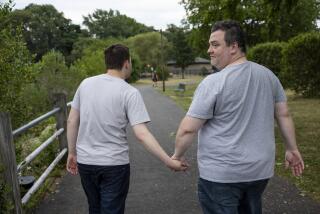The Magic Touch : Keyboard Technique Helps Severely Disabled Students Learn to Communicate
- Share via
MISSION VIEJO — For years, Pam and John Miller wondered whether their 16-year-old autistic son, Morgan, heard or understood anything they said. He never spoke, never responded to their requests and thumbed aimlessly through magazines.
But now, with a keyboard and the encouraging touch of a human hand, Morgan has learned to communicate some of his thoughts.
“He can now type what he wants for breakfast. He can type to me what he feels. He can tell me what he wants to do. We realized he understood everything,” Pam Miller said, her voice cracking, as she recalled her years of doubting.
Since early this year, Orange County’s speech and language program for severely disabled children has utilized this form of “facilitated communication,” a program first tried in Australia. Communicating through keyboard writing is allowing families such as the Millers to realize that their children, previously thought to be unteachable, can read, write and process thoughts.
The technique is deceptively simple: The teacher touches the student on the hand, arm or shoulder, while the student types on a computer keyboard or on a hand-held word-processing machine. Many children quickly pick up how to type with one finger and seem to draw upon a reservoir of words and events stored in their memory.
First introduced in the United States in late 1989 by Douglas Biklen, director of the special education and rehabilitation division at Syracuse University, it caught the attention of Pam Miller when she saw it featured last February on the television show “20/20.”
Shortly afterward, she attended a one-day workshop with her son’s teacher, Helen Cramer. Both were impressed by what they learned.
“I didn’t understand the concept or technique until then,” said Cramer, who teaches at Mission Viejo High School Special Classes, one of two county sites that specialize in speech and language skills. “I didn’t realize it could be applied to my students. I didn’t know that they could already read and spell words.”
Cramer said the method has radically altered how she conducts her classes. Four of her seven students have benefited tremendously. One showed some improvement and two made no gains.
“I use (facilitated communication) throughout the day, on a functional basis. I’ve always used words with them, but often I asked yes-or-no questions. Before, I asked a student: ‘Do you want mustard on your hot dog?’ Now, I ask: ‘What do you want on your hot dog?’ And they will answer, ‘Ketchup,’ ” Cramer said.
Teacher Michael Peer of Gill Special Education Center in Huntington Beach said he never suspected that Tracee, a teen-ager who is prone to rocking and beating herself, would be capable of communicating with written words. Now, she is his most successful student.
“We had been talking with her for years and not getting a response. She’d just look at us, like, yeah, all right,” Peer said. “Before we only knew how she was feeling if she was crying or smiling.”
In a recent class, Tracee typed “hungry” when asked how she was feeling. When Peer asked her what she wanted, she wrote “food.” Pressing for something more specific, he asked her: “Like what?” She replied: “Hot dog, slerpee.”
“She becomes very calm when she is communicating. She shows no self-abusive behavior. The improvement she shows when she’s communicating is unbelievable,” Peer said.
Mary Winston Morton, a graduate student who works with Biklen, said researchers theorize that it is easier for the disabled individual to control the movement of a hand or finger than it is to speak.
“People have difficulty with voluntary movement, initiating, stopping, controlling the performance of that movement. Pointing with one finger to something is simple. Speech is very complex,” Morton said.
Difficulty in speaking or understanding language is a common symptom of autism, a developmental disorder that emerges before the age of 4. Other symptoms are an inability to relate socially to other people, unresponsiveness and an insistence on routines.
Facilitated communication is also being used with children who are mentally and physically retarded by Down’s syndrome, Lesch-Nyhan syndrome or severe cerebral palsy.
Ed and Louise McNew’s 20-year-old son, James, was believed to have the intelligence of an 18-month-old. Until this year, he communicated with facial expressions, or by pointing to pictures and pressing buttons on a machine that issued a variety of recorded requests or statements, such as “I am hungry” or “I need to go to the bathroom.”
But since spending time on the computer with his instructors, his skills have sharpened noticeably.
“Over Easter, his speech therapist had an open-ended conversation with him,” Louise McNew said. “She asked him what he had for lunch and he answered, ‘Taco salad.’ She asked him how he was, and he answered: ‘Fine. I hope you are fine too.’ Every word was spelled correctly.”
An intriguing aspect of the technique is that the disabled individual must be touched by someone he or she trusts in order to type thoughts. The facilitator does not type out words but sometimes steadies the hand.
Human contact “seems to help people initiate the process, to overcome the problem of getting started,” Biklen said. “The idea is not to guide, but to provide some background support.”
More to Read
Sign up for Essential California
The most important California stories and recommendations in your inbox every morning.
You may occasionally receive promotional content from the Los Angeles Times.













